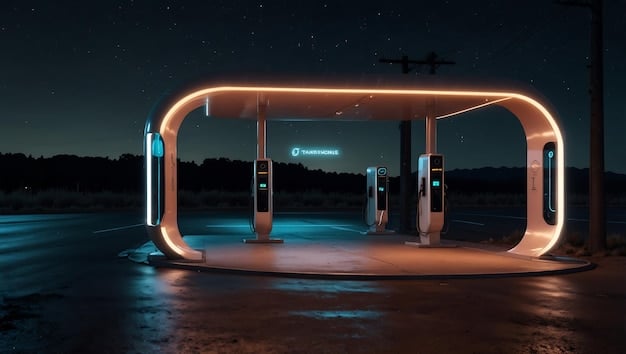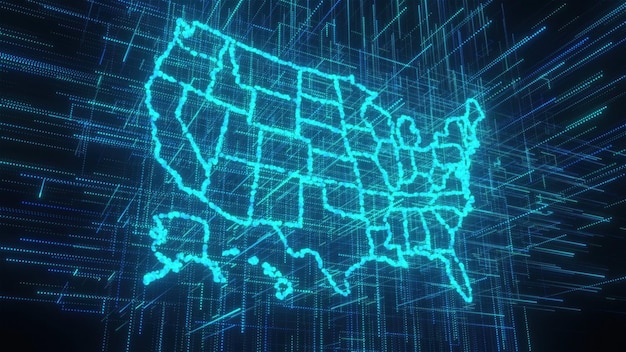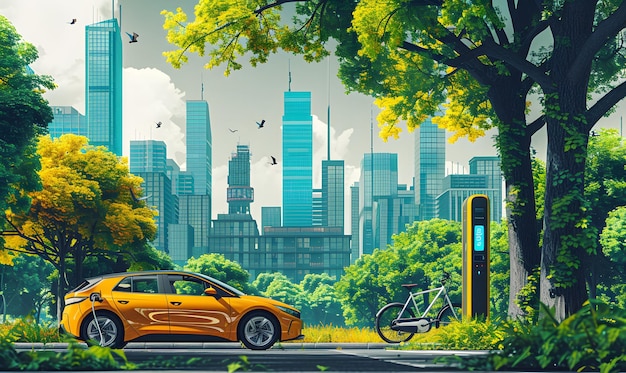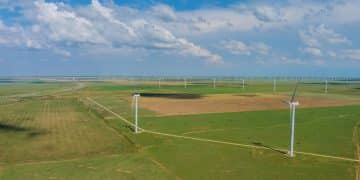EV Sales Spike 7%: Future of US Transportation?

The 7% increase in electric vehicle sales nationwide signals a critical shift towards sustainable transportation in the US, indicating growing consumer acceptance and hinting at profound implications for infrastructure, energy grids, and traditional automotive industries.
The automotive landscape in the United States is undergoing a significant transformation, with electric vehicles (EVs) at the forefront of this revolution. When we consider what a 7% increase in electric vehicle sales nationwide means for the future of US transportation, it reveals far more than a simple statistical uptick; it points to a profound shift in consumer behavior, technological advancement, and an impending restructuring of infrastructure and industry across the nation.
Understanding the 7% Surge
The recent 7% increase in electric vehicle sales represents a pivotal moment, shifting EVs from a niche market to a burgeoning mainstream segment. This growth isn’t arbitrary; it reflects a convergence of factors including evolving consumer preferences, technological maturity, and supportive governmental policies aimed at accelerating adoption nationwide.
Historically, EVs faced significant hurdles, from range anxiety to prohibitive costs and a nascent charging infrastructure. However, the past few years have seen remarkable progress in battery technology, leading to longer ranges and faster charging times. Simultaneously, increased competition among manufacturers has driven down prices, making EVs more accessible to a broader demographic. Furthermore, a growing environmental consciousness among consumers is undeniably a major propellant for this sales growth, with many actively seeking greener alternatives to traditional gasoline-powered vehicles.
Key Drivers Behind the Growth
Several interconnected elements contribute to this notable increase, creating a powerful synergy that propels EV adoption forward. Understanding these drivers is crucial for projecting future trends and challenges.
- Technological Advancements: Improved battery density, faster charging capabilities, and enhanced vehicle performance diminish previous concerns about EV practicality.
- Government Incentives: Federal tax credits, state rebates, and local perks like HOV lane access make EVs more financially appealing to potential buyers.
- Expanded Model Availability: A greater variety of EV models, from sedans to SUVs and trucks, caters to diverse consumer needs and preferences, expanding the addressable market.
The evolving perception of EVs, from a mere environmental statement to a practical and often superior mode of transport, is also paramount. Consumers are increasingly valuing the lower operating costs, reduced maintenance, and the quiet, responsive driving experience that EVs offer. This blend of evolving consumer sentiment, regulatory support, and technological innovation forms the bedrock of the current sales surge and lays the groundwork for even greater adoption in the coming years.
Infrastructure Demands and Evolution
A significant sales increase inevitably places greater demands on the nation’s charging infrastructure. The current pace of charging station deployment, while accelerating, will need to match or exceed the rate of EV adoption to avoid bottlenecks and ensure a smooth transition. This expansion isn’t just about quantity; it’s about strategic placement, reliability, and the capacity to handle diverse charging needs.
Addressing “range anxiety” remains a critical component of mainstream EV acceptance. While newer models boast impressive ranges, the ubiquitous availability of charging points, particularly on long-distance routes and in multi-unit dwellings, is essential. This requires substantial investments from both public and private sectors to build out a robust network.
Public vs. Private Charging Solutions
The growth of EV charging infrastructure is largely a dual effort, involving both government initiatives and private enterprise. Each plays a distinct yet complementary role in building a comprehensive network.
- Public Charging Networks: Government funding and partnerships are crucial for establishing charging hubs in strategic locations, including highway corridors, public parking lots, and urban centers. These networks often aim to provide universal access and standardize charging protocols.
- Private Charging Solutions: The rise of home charging (Level 2 chargers) and workplace charging significantly contributes to daily and overnight charging needs. Additionally, private companies are rapidly expanding commercial charging options, from rapid chargers at retail locations to destination chargers at hotels and restaurants.
The integration of smart charging technologies, which can optimize charging times to align with off-peak electricity rates and grid availability, will also be vital. This intelligent approach can help manage increased demand on the electrical grid, ensuring stability and efficiency as more EVs come online. Building a resilient and widespread charging infrastructure is not merely a convenience; it is a foundational pillar for supporting the sustained growth of the EV market and realizing its potential to transform US transportation.
Impact on the Energy Grid
The increased adoption of EVs, evidenced by the 7% sales rise, directly translates to a greater demand for electricity. This shift presents both challenges and opportunities for the nation’s energy grid, requiring careful planning and substantial investment in power generation, transmission, and distribution.
While the overall electricity consumption attributable to EVs is currently a small fraction of the total, a continued exponential rise necessitates a forward-looking strategy. The “fueling” of millions more vehicles will require the grid to be more robust, more intelligent, and potentially, more diversified in its power sources.
Renewable Energy Integration
The environmental benefit of EVs is maximized when the electricity used to charge them comes from renewable sources. This provides a strong impetus for accelerating the transition to clean energy generation.
- Solar and Wind Power: Investing in utility-scale solar and wind farms can provide clean, sustainable energy for EV charging, aligning with environmental goals and reducing reliance on fossil fuels.
- Hydropower and Geothermal: Diversifying the renewable energy portfolio with sources like hydropower and geothermal further enhances grid reliability and sustainability.
Moreover, the concept of vehicle-to-grid (V2G) technology holds immense promise. V2G allows EVs to not only draw power from the grid but also to return excess stored energy during peak demand periods, effectively transforming a fleet of EVs into a massive distributed energy storage system. This bidirectional flow of energy can help stabilize the grid, improve efficiency, and even generate revenue for EV owners. Ultimately, the successful integration of EVs into the energy landscape hinges on a proactive approach to grid modernization and a strong commitment to renewable energy sources, ensuring that the environmental promise of EVs is fully realized.

Economic Implications and Job Market Shifts
The growing electric vehicle market, highlighted by the 7% sales increase, is already sending ripples through the US economy, initiating significant shifts in manufacturing, supply chains, and the broader job market. This transition means new opportunities but also requires adaptation from established industries.
Traditional automotive manufacturing, historically centered around internal combustion engine (ICE) components, is pivoting towards EV production. This involves retooling factories, reskilling workers, and fostering innovation in battery technology, electric motors, and power electronics. The investment required for this transformation is substantial, but the potential for long-term economic growth and global competitiveness is immense.
Emerging Industries and Skill Sets
The EV revolution isn’t just about cars; it’s about an entire ecosystem of supporting industries. This creates new job categories and demands for specialized skills.
- Battery Manufacturing and Recycling: A clear need for expertise in lithium-ion battery production, raw material sourcing, and end-of-life recycling processes.
- Charging Infrastructure Development: Jobs in electrical engineering, construction, and network management for installing and maintaining charging stations.
- Software and Data Analytics: Development of advanced software for EV operation, charging management, and fleet optimization, requiring programming and data science skills.
While some traditional jobs related to ICE vehicle maintenance and fossil fuel infrastructure may decline, the net effect is expected to be a positive increase in employment, particularly in high-tech manufacturing and clean energy sectors. Furthermore, the growth of a robust EV ecosystem can enhance national energy security by reducing reliance on imported oil and fostering domestic innovation. This economic pivot signifies a move towards a more sustainable, technologically advanced, and resilient industrial base for the United States.
Environmental and Health Benefits
Beyond the economic and infrastructural shifts, the 7% increase in EV sales has profound implications for environmental quality and public health. This growth accelerates the transition away from fossil fuels, directly addressing concerns about air pollution and climate change.
Internal combustion engine vehicles are major contributors to greenhouse gas emissions and local air pollutants like nitrogen oxides and particulate matter, which have significant detrimental effects on respiratory health. By replacing these vehicles with EVs, even when considering grid emissions, there’s a substantial reduction in tailpipe emissions, particularly in urban areas.
Cleaner Air and Reduced Emissions
The widespread adoption of EVs offers a direct pathway to cleaner air, especially in densely populated cities where vehicle emissions are concentrated.
- Lower Urban Pollution: EVs produce zero tailpipe emissions, leading to improved air quality in residential areas and along busy roadways, directly benefiting public health.
- Reduced Greenhouse Gases: As the grid becomes greener, the overall carbon footprint of EVs becomes significantly lower than that of gasoline cars, contributing to climate change mitigation efforts.
The shift to EVs also reduces noise pollution, particularly in urban environments, contributing to a more pleasant and serene living experience. This quieter operation benefits both residents and wildlife. While the production of EV batteries and components has an associated environmental footprint, ongoing innovations in manufacturing processes and recycling technologies are continuously working to minimize these impacts. The net environmental and health benefits of widespread EV adoption are overwhelmingly positive, representing a critical step towards a more sustainable and healthier future for communities across the US.

Future Outlook and Policy Considerations
The 7% increase in EV sales is not merely a statistical anomaly but a strong indicator of an accelerating trend that will reshape US transportation for decades to come. Projecting forward, this growth trajectory suggests a future where EVs are not just common, but dominant. However, this future is not guaranteed; it depends heavily on continued policy support, technological breakthroughs, and persistent behavioral shifts.
Government policies will remain crucial in shaping the pace and direction of EV adoption. This includes maintaining and evolving tax incentives, investing in research and development for next-generation battery technologies, and implementing regulations that encourage fleet electrification and the build-out of comprehensive charging infrastructure. Consistency and predictability in these policies are vital for industry investment and consumer confidence.
Challenges and Opportunities Ahead
While the outlook is largely positive, several challenges must be navigated to ensure a smooth and equitable transition to an electric transportation system.
- Raw Material Sourcing: Ensuring a stable and ethical supply chain for critical battery materials like lithium, cobalt, and nickel is paramount.
- Grid Resiliency: Strengthening the national grid to handle increased demand and integrate more renewable energy sources will require substantial investment and modernization.
- Consumer Education and Equity: Addressing lingering misconceptions about EVs and ensuring access and affordability for all socioeconomic groups will be key to widespread adoption.
The opportunities, however, far outweigh the challenges. The shift to EVs can solidify the US position as a leader in automotive innovation, create new export industries, and significantly improve public health and environmental quality. By proactively addressing the challenges and seizing the opportunities, the United States can harness the momentum from this 7% sales increase and drive towards a cleaner, more efficient, and more sustainable transportation future, benefiting generations to come.
| Key Aspect | Brief Description |
|---|---|
| 📈 Market Growth | 7% EV sales increase signifies mainstream adoption, driven by tech and incentives. |
| ⚡ Infrastructure Needs | Expansion of robust and smart charging networks is crucial for sustained growth. |
| 💡 Energy Grid Impact | Increased demand for electricity and accelerated shift to renewable energy sources. |
| 🌍 Environmental Benefits | Cleaner air, reduced noise pollution, and significant cuts in greenhouse gas emissions. |
Frequently asked questions (FAQ) about EV Growth
The current surge in EV sales is primarily driven by advancements in battery technology, which provide longer ranges and faster charging. Additionally, government incentives like tax credits and a wider variety of available models that cater to diverse consumer needs have made EVs more appealing and accessible to a broader market across the US.
A 7% increase in EV sales will significantly raise electricity demand, necessitating grid modernization and increased renewable energy integration. This includes investing in solar, wind, and potentially vehicle-to-grid (V2G) technologies, where EVs can return power to the grid during peak times, enhancing stability and efficiency nationwide.
The main challenges for EV infrastructure expansion include the rapid deployment of sufficient charging stations, particularly in rural areas and multi-unit dwellings. Ensuring charging reliability, standardizing charging protocols, and integrating smart charging solutions to manage increased grid demand are also crucial hurdles that need to be addressed effectively.
Increased EV adoption leads to significant environmental benefits, including zero tailpipe emissions, which reduce urban air pollution and improve public health. It also contributes to a substantial reduction in greenhouse gas emissions, especially as the electricity grid incorporates more renewable energy sources, helping combat climate change and fostering cleaner communities.
EV growth is set to reshape the US job market by creating new positions in battery manufacturing, charging infrastructure development, and software engineering. While some traditional automotive jobs may shift, the overall impact is expected to be a net increase in high-tech manufacturing and clean energy employment, fostering economic growth and innovation nationwide.
Conclusion
The 7% increase in electric vehicle sales nationwide is more than a statistic; it is a clear indicator of an accelerating transition towards a more sustainable and technologically advanced transportation future for the United States. This growth underscores a pivotal shift in consumer behavior, driven by evolving technology, robust government support, and a heightened environmental consciousness. While significant challenges remain, particularly concerning infrastructure expansion, grid modernization, and supply chain stability, the opportunities presented by this shift are immensely promising. The move towards electrification offers substantial environmental benefits, including cleaner air and reduced carbon emissions, alongside dynamic economic shifts creating new industries and job markets. By proactively addressing these challenges and embracing the continued innovation within the EV sector, the US stands poised to lead in this global transformation, building a more resilient, efficient, and environmentally friendly transportation system for generations to come. The journey is certainly in motion, and the implications of this growth are set to redefine mobility across the nation.





